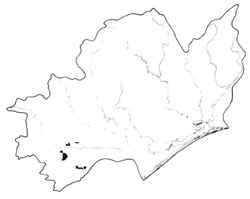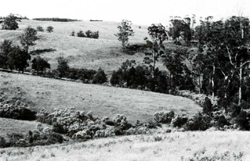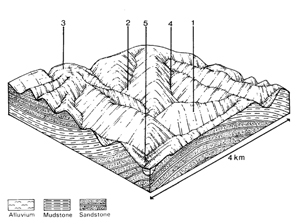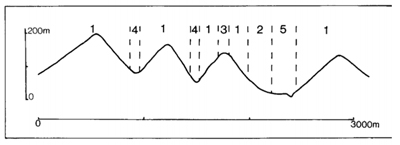Haunted Hills (HH)
 | Area: 29 sq. km (0.2%) This land system occurs on Tertiary deposits uplifted with the South Victorian Uplands and the Yallourn Monocline movements. It is deeply dissected and elevation and relief are higher than in many other areas of Tertiary materials. The terrain consists of very high hills or low mountains, typically with a ridge-and-ravine topography and sometimes with very steep slopes, such as in the Yallourn North and Kornalla areas. Some broad ridge crests and less-steep slopes do occur. The soil parent materials, which range from gravelly deposits to clays, have been variably modified by weathering processes. All the soils observed have deep clayey subsoils and leached acidic profiles. The upper horizons are commonly loamy or sandy. In places the subsoils and underlying layers are highly dispersive and tend to become fluid when wet. They are susceptible to gullying and slumping. The vegetation is mainly open forest II with open forest III in drainage gullies and ravines. |  Broad ridge crests and spurs with a few short, steep side-slopes. |
| CLIMATE Rainfall, mean (mm) Temperature, mean (°C) Seasonal growth limitations | Annual 700 - 1200; lowest January (40 - 70), highest October (70 - 100) Annual 12 - 14; lowest July (8 - 10), highest February (19 - 21) Temperature <10°C (av.): May - September Rainfall < potential evapotranspiration: November – March |
| GEOLOGY Age, lithology | Unconsolidated Tertiary deposits of sands, clays and gravels |
| PHYSIOGRAPHY Landscape Elevation range (m) Relative relief (m) Drainage pattern Drainage density (km/km2) | Steep hills and low mountains with mainly ridge-and-ravine topography 60 - 300 100 - 200 Dendritic 1.3 |
| PRESENT LAND USE | Mostly uncleared: hardwood forestry (minor timber products); apiculture; bush grazing of cattle (limited). Minor proportion cleared: grazing of beef and dairy cattle and sheep on improved pastures |
 |  |
| LAND COMPONENT Percentage of land system Diagnostic features | 1 60 Steep slopes, in places showing evidence of landslides | 2 30 Broad ridge crests | 3 10 Steeper slopes of drainage gullies and ravines |
| PHYSIOGRAPHY Slopes %, typical and (range) Slope shape | 20 - 25, (10 - 40) Straight | 4, (0 - 10) Convex | 15 - 20, (10 - 25) Straight |
| SOIL | |||
| Parent material | Very variable — sand, clay, gravel; ferruginised and silicified sediment; rarely, basaltic colluvium from adjacent land systems | ||
| Description | Variable; depending on local parent material— commonly gradational and duplex profiles, mainly with yellowish brown, less frequently with reddish brown, clay subsoil; moderately to strongly acid. May contain gravel | Limited observations — probably similar to components 1 and 2 with shallower variants on very steep slopes | |
| Classification | Yellow Earths, Yellow Podzolic Soils, Red Podzolic Soils/Krasnozems Gn2.84, Gn3.14, Gn4.51, Dy3.11, Dy5.21 | Brown Earths Gn4.82 | |
| Surface texture | Very variable; loamy sand to sandy clay loam | - | |
| Surface consistence | Hard, sometimes slightly hard | ||
| Depth (m) | >2.0 | ||
| Nutrient status | Usually low | ||
| Available soil water capacity | Low to moderate | ||
| Perviousness to water | Slow | ||
| Drainage | Somewhat poor to good | ||
| Exposed stone (%) | 0 | ||
| Sampled profile number | - | ||
| NATIVE VEGETATION Structure of vegetation and characteristic species of dominant stratum (+ Predominant species) | Open forest II: Usually mixed forests with species composition E. consideniana, E. obliqua, E. radiata, | Open forest II: and predominance variable — including E. sieberi E. dives, E. cypellocarpa | Open forest III, often shrubby: Usually mixed forests with species composition and predominance variable — including E. consideniana, E. obliqua, E. radiata, E. sieberi, E. dives, E. cypellocarpa; E. viminalis on occasional alluvium in gullies |
Disturbance | Affected process and trend | Primary resultant deterioration | Casual activities | Primary off-site process | ||
Form | Susceptibility of components | Incidence with components | ||||
— reduction in leaf area, rooting depth and/or perenniality |
resulting in: a) increased deep percolation b) increased regolith wetness |
|
|
|
|
|
|
|
|
2; moderate |
|
|
|
|
With Reduced infiltration |
Sheet and rill erosion |
3; moderate 1,3; high 2; moderate |
Uncommon |
As for sheet and rill erosion above |
Increased flash flows |
|
|
Streambank erosion |
2; moderate 3; moderate - high |
Uncommon |
As for sheet and rill erosion above |
Increased sediment load |
| ||||||


